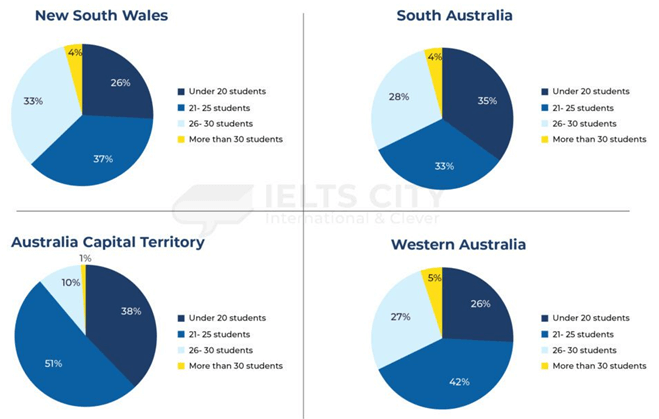5+ The pie charts show the size of classes in primary schools in four states in Australia
The pie charts show the size of classes in primary schools in four states in Australia in 2010. Summarise the information by selecting and reporting the main features, and make comparisons where relevant. Write at least 150 words hay nhất giúp bạn có thêm tài liệu tham khảo để viết bài luận bằng Tiếng Anh hay hơn.
- The pie charts show the size of classes in primary schools in four states in Australia (mẫu 1)
- The pie charts show the size of classes in primary schools in four states in Australia (mẫu 2)
- The pie charts show the size of classes in primary schools in four states in Australia (mẫu 3)
- The pie charts show the size of classes in primary schools in four states in Australia (mẫu 4)
- The pie charts show the size of classes in primary schools in four states in Australia (mẫu 5)
- The pie charts show the size of classes in primary schools in four states in Australia (mẫu 6)
5+ The pie charts show the size of classes in primary schools in four states in Australia
Đề bài: The pie charts show the size of classes in primary schools in four states in Australia in 2010. Summarise the information by selecting and reporting the main features, and make comparisons where relevant. Write at least 150 words
The pie charts show the size of classes in primary schools in four states in Australia - mẫu 1
These four provided pie charts illustrate the distribution of several primary school class sizes across four Australian states in 2010: New South Wales, South Australia, the Australian Capital Territory, and Western Australia.
Overall, it can be seen that while medium-sized classes are a common feature in these states, the prevalence of smaller and larger classes varies, likely reflecting diverse educational policies or regional challenges.
A common trend is the preference for class sizes of 21-25 students across all states. This range is most prominent in the Australian Capital Territory, representing nearly half the classes (51%), suggesting a regional preference for medium-sized classes. In New South Wales and Western Australia, these classes form nearly two-fifths, with 37% and 42%, respectively.
Classes with 20 students or fewer vary notably among the states, being most common in the Australian Capital Territory (38%) and South Australia (35%), and less so in New South Wales and Western Australia (both 26%). This variation may reflect different educational strategies or demographics.
Larger classes with 26-30 students are somewhat evenly distributed, with New South Wales and South Australia having around a third and a quarter of their classes in this range, respectively. In contrast, the Australian Capital Territory has only 10% of its classes in this size, indicating a distinct approach to class sizes.
Classes exceeding 30 students are rare across the board, ranging from 1% in the Australian Capital Territory to 5% in Western Australia, pointing to a general policy against very large class sizes.
The pie charts show the size of classes in primary schools in four states in Australia - mẫu 2
The presented pie charts offer an elaborate breakdown of class capacities in primary schools in four different areas in Australia in the year 2010.
In an overarching context, it can be explicitly observed that the most notable paradigm was the classes exclusively ranging from 21 to 25 students, except for South Australia. Additionally, the classes surpassing 30 students occupied the most trifling segments among the four analyzed regions.
Looking first at New South Wales, 37% of primary-level classes were made up of from 21 to 25 students, closely followed by classes accommodating between 26 to 30 pupils and restricted to a maximum of 20 students (33% and 26% in that order). A different scenario is demonstrated graphically in South Australia where the allocations of class capacities below 31 pupils were from 28% to 35%, with classes with no more than 20 students being the most substantial ones. Strikingly, both regions jointly represented the most insignificant percentage at 4% for classes above 30 students.
Turning to Australia Capital Territory and Western Australia, the prevalent class size was 21-25 students, accounting for slightly over half and 42%, respectively. In the former, the statistics for the smallest class capacity achieved 38%, which outnumbered the 26-30 class size by 28%. However, the opposite trend was true for the latter where the proportions of classes under 20 and 21-25 students depicted some marked dissimilarities, representing 26% and 27% for each. Concurrently, classes exceeding 30 students amounted to the least significant sector, at 1% and 5%.
The pie charts show the size of classes in primary schools in four states in Australia - mẫu 3
The charts give a breakdown of class sizes in primary schools across four Australian regions in 2010.
Overall, classes having 21-25 students held the largest share in all four states surveyed, except for South Australia, where classes with under 20 students were most common. In contrast, classes containing over 29 students were a rarity in these areas.
Looking first at New South Wales, 37% of the primary-level classes in this state had 21-25 students, followed closely by those with 26-30 and fewer than 20 students (33% and 26% respectively). In South Australia, meanwhile, the percentages of classes comprising under 31 students ranged from 28% to 35%, with classes having a maximum of 20 students being the most popular. Notably, the figures for the biggest class size in both states were the same, each standing at only 4%.
Turning to Australia Capital Territory, classes consisting of 21-25 students constituted the majority, at just over half of all class sizes listed, compared to 38% of classes having no more than 20 students. This was in stark contrast to classes with 26-30 students, making up one-tenth of the total, ten times higher than the smallest class size. In Western Australia, the predominant class size was, again, 21-25 students, occupying 42%, while a negligible difference was observed in the proportions of classes with under 20 and 26-30 students, with figures of 26% and 27%, in that order. In the last position was the largest class size, as its share was only 5%.
The pie charts show the size of classes in primary schools in four states in Australia - mẫu 4
The pie charts compare class size distributions in four Australian states: New South Wales, South Australia, the Australian Capital Territory, and Western Australia in 2010.
Overall, each state exhibited variations in class size ratios, but classes with over 30 students accounted for the smallest proportion of all classes in each state.
Specifically, class size distributions in New South Wales and South Australia showed several similarities and differences. Both states had 4% of classes with more than 30 students, indicating a small proportion of larger classes. Additionally, each of the three remaining class groups, which are fewer than 20 students, 21-25 students and 26-30 students, represented approximately a third of the total number of classes.
Concerning the Australian Capital Territory, classes with 26-30 students constituted 51%, and a significant share of smaller classes with fewer than 20 students at 38%. In contrast, Western Australia favored classes with 21-25 students at 42% and had a more balanced distribution. Furthermore, the Australian Capital Territory had the lowest percentage of classes with over 30 students (1%), while Western Australia had a slightly higher proportion (5%). These variations highlight different class size preferences, with the Australian Capital Territory emphasizing smaller classes and Western Australia leaning toward mid-sized classes of 21-25 students.
The pie charts show the size of classes in primary schools in four states in Australia - mẫu 5
The charts categorize classes in four Australian states based on the number of students attending.
Overall, classes consisting of over 30 students occupy the most modest proportions, while it is more common for classes in the mentioned states to have between 21 and 25 students than larger or smaller sizes.
The Australian Capital Territory is a representative of the two states with the most common class size (21–25 students), while the other is Western Australia, at figures of 51% and 43%, respectively. Classes with 20 students and below, as well as those with 26–30 students, display minor differences between these two states, at 20–25% for the former and 27–29% for the latter.
However, the majority of classes in New South Wales comprise fewer students, with up to 40% consisting of only 20 students and lower, although those with more students are not uncommon, at around 30% individually. Meanwhile, in South Australia, larger classes (26–30 students) account for up to 44%, compared to 23% of those with 21–25 students.
Finally, one salient feature that all four states share is that only a slight number of classes contain more than 30 students, at only 2–3%.
The pie charts show the size of classes in primary schools in four states in Australia - mẫu 6
The pie charts provide information about the average numbers of students per class in different Australian states.
Overall, in all the examined areas, the majority of classes are comprised of fewer than 30 students each, with the class size of 21 to 25 students being the most common, except in South Australia. Meanwhile, the Australia Capital Territory has the smallest average class size compared to the other regions.
Starting with smaller class sizes, Australia Capital Territory takes the lead for classes with 20 students or fewer, at 38%, followed by South Australia, which is 3% lower. The corresponding percentages for New South Wales and Western Australia are smaller, both at 26%. Classes of 21-25 students constitute more than half (51%) of the total in the Australia Capital Territory, which is nearly 10% higher than in Western Australia, where it stands at 42%. This category makes up around one-third of all classes in the other two regions.
In contrast, the larger class size of 26 to 30 students is less prevalent, with the highest percentage observed in New South Wales at 33%, 5-6% higher than in both South Australia and Western Australia. The Australia Capital Territory only has 10% of its classes in this size bracket, and only 1% of their classes exceed 30 students, while the figures for the remaining three states vary from 4% to 5%.
Xem thêm các bài luận Tiếng Anh hay khác:
Đã có app VietJack trên điện thoại, giải bài tập SGK, SBT Soạn văn, Văn mẫu, Thi online, Bài giảng....miễn phí. Tải ngay ứng dụng trên Android và iOS.
Theo dõi chúng tôi miễn phí trên mạng xã hội facebook và youtube:Nếu thấy hay, hãy động viên và chia sẻ nhé! Các bình luận không phù hợp với nội quy bình luận trang web sẽ bị cấm bình luận vĩnh viễn.
- Đề thi lớp 1 (các môn học)
- Đề thi lớp 2 (các môn học)
- Đề thi lớp 3 (các môn học)
- Đề thi lớp 4 (các môn học)
- Đề thi lớp 5 (các môn học)
- Đề thi lớp 6 (các môn học)
- Đề thi lớp 7 (các môn học)
- Đề thi lớp 8 (các môn học)
- Đề thi lớp 9 (các môn học)
- Đề thi lớp 10 (các môn học)
- Đề thi lớp 11 (các môn học)
- Đề thi lớp 12 (các môn học)
- Giáo án lớp 1 (các môn học)
- Giáo án lớp 2 (các môn học)
- Giáo án lớp 3 (các môn học)
- Giáo án lớp 4 (các môn học)
- Giáo án lớp 5 (các môn học)
- Giáo án lớp 6 (các môn học)
- Giáo án lớp 7 (các môn học)
- Giáo án lớp 8 (các môn học)
- Giáo án lớp 9 (các môn học)
- Giáo án lớp 10 (các môn học)
- Giáo án lớp 11 (các môn học)
- Giáo án lớp 12 (các môn học)






 Giải bài tập SGK & SBT
Giải bài tập SGK & SBT
 Tài liệu giáo viên
Tài liệu giáo viên
 Sách
Sách
 Khóa học
Khóa học
 Thi online
Thi online
 Hỏi đáp
Hỏi đáp

